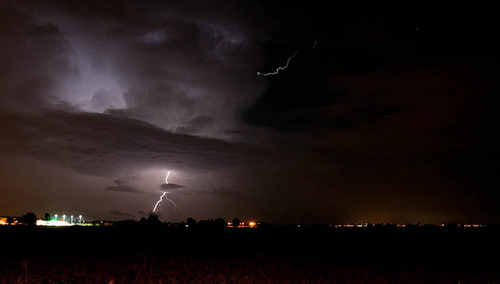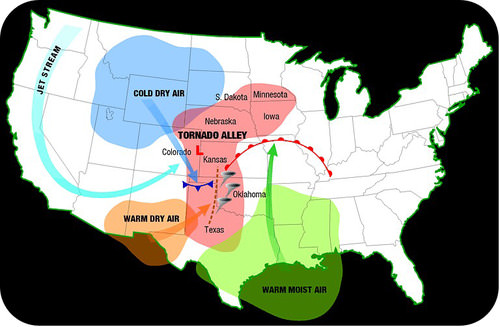16.3 Storms
16.3 Storms
Lesson Objectives
- Define storm.
- Explain why thunderstorms occur.
- Describe tornadoes.
- Explain how hurricanes form.
- Identify two types of winter storms.
Vocabulary
- blizzard
- hurricane
- lake-effect snow
- lightning
- storm
- storm surge
- thunder
- thunderstorm
- tornado
- windchill
Introduction
In 2005, Hurricane Katrina caused a huge flood in the city of New Orleans. Figure below shows what the city looked like after the hurricane. Mile after mile of homes and businesses were covered with flood water. Billions of dollars of damage were done. More than 2,000 people died. Hurricanes are extremely strong storms and Katrina was stronger than most. What are storms? What causes them? And what gives a storm its strength? Read on to find out.
A coast guard officer looks for survivors of Hurricane Katrina.
What Are Storms?
A storm is an episode of severe weather caused by a major disturbance in the atmosphere. Storms can vary a lot in the time they last and in how severe they are. A storm may last for less than an hour or for more than a week. It may affect just a few square kilometers or thousands. Some storms are harmless and some are disastrous. The size and strength of a storm depends on the amount of energy in the atmosphere. Greater differences in temperature and air pressure produce stronger storms. Types of storms include thunderstorms, tornadoes, hurricanes, and winter storms such as blizzards.
Thunderstorms
Thunderstorms are are known for their heavy rains and lightning. In strong thunderstorms, hail and high winds are also likely. Thunderstorms are very common. Worldwide, there are about 14 million of them each year! In the U.S., they are most common — and strongest — in the Midwest.
What Causes Thunderstorms?
Thunderstorms occur when the air is very warm and humid. The warm air rises rapidly to create strong updrafts. When the rising air cools, its water vapor condenses. The updrafts create tall cumulonimbus clouds called thunderheads. You can see one in Figure below.
A thunderhead is a cumulonimbus cloud.
Lightning and Thunder
During a thunderstorm, some parts of a thunderhead become negatively charged. Other parts become positively charged. The difference in charge creates lightning. Lightning is a huge release of electricity. Lightning can jump between oppositely charged parts of the same cloud, between one cloud and another, or between a cloud and the ground. You can see lightning in Figure below. Lightning blasts the air with energy. The air heats and expands so quickly that it explodes. This creates the loud sound of thunder.
Do you know why you always hear the boom of thunder after you see the flash of lightning? It’s because light travels faster than sound. If you count the seconds between seeing lightning and hearing thunder, you can estimate how far away the lightning was. A lapse of 5 seconds is equal to about a mile.
Lightning flashes across an Arizona sunset.
Tornadoes
Severe thunderstorms have a lot of energy and strong winds. This allows them to produce tornadoes. A tornado is a funnel-shaped cloud of whirling high winds. You can see a tornado in Figure below. The funnel moves along the ground, destroying everything in its path. As it moves it loses energy. Before this happens it may have gone up to 25 kilometers (16 miles). Fortunately, tornadoes are narrow. They may be only 150 meters (500 feet) wide.
Tornadoes are small but mighty storms.
Classifying Tornadoes
The winds of a tornado can reach very high speeds. The faster the winds blow, the greater the damage they cause. Wind speed and damage are used to classify tornadoes. Table below shows how.
| F Scale | (km/hr) | (mph) | Damage |
|---|---|---|---|
| F0 | 64-116 | 40-72 | Light - tree branches fall and chimneys may collapse |
| F1 | 117-180 | 73-112 | Moderate - mobile homes, autos pushed aside |
| F2 | 181-253 | 113-157 | Considerable - roofs torn off houses, large trees uprooted |
| F3 | 254-332 | 158-206 | Severe - houses torn apart, trees uprooted, cars lifted |
| F4 | 333-419 | 207-260 | Devastating - houses leveled, cars thrown |
| F5 | 420-512 | 261-318 | Incredible - structures fly, cars become missiles |
| F6 | >512 | >318 | Maximum tornado wind speed |
Tornado Alley
Look at the map in Figure below. It shows where the greatest number of tornadoes occur in the U.S. Tornadoes can happen almost anywhere in the U.S. but only this area is called “tornado alley.” Why do so many tornadoes occur here? This is where warm air masses from the south run into cold air masses from the north.
Tornadoes are most common in the central part of the U.S.
Hurricanes
Tornadoes may also come from hurricanes. A hurricane is an enormous storm with high winds and heavy rains. Hurricanes may be hundreds of kilometers wide. They may travel for thousands of kilometers. The storm's wind speeds may be greater than 251 kilometers (156 miles) per hour. Hurricanes develop from tropical cyclones.
Hurricanes form over warm very ocean water. This water gives them their energy. As long as a hurricane stays over the warm ocean, it keeps growing stronger. However, if it goes ashore or moves over cooler water, it is cut off from the hot water energy. The storm then loses strength and slowly fades away.
The Eye of a Hurricane
At the center of a hurricane is a small area where the air is calm and clear. This is the eye of the hurricane. The eye forms at the low-pressure center of the hurricane. You can see the eye of a hurricane in Figure below.
The eye of this hurricane is easy to see from space.
Classifying Hurricanes
Like tornadoes, hurricanes are classified on the basis of wind speed and damage. Table below shows how.
| Category | Kph | Mph | Damage |
|---|---|---|---|
| 1 (weak) | 119-153 | 74-95 | Above normal; no real damage to structures |
| 2 (moderate) | 154-177 | 96-110 | Some roofing, door, and window damage, considerable damage to vegetation, mobile homes, and piers |
| 3 (strong) | 178-209 | 111-130 | Some buildings damaged; mobile homes destroyed |
| 4 (very strong) | 210-251 | 131-156 | Complete roof failure on small residences; major erosion of beach areas; major damage to lower floors of structures near shore |
| 5 (devastating) | >251 | >156 | Complete roof failure on many residences and industrial buildings; some complete building failures |
Storm Surge
Some of the damage from a hurricane is caused by storm surge. Storm surge is very high water located in the low pressure eye of the hurricane. The very low pressure of the eye allows the water level to rise above normal sea level. Storm surge can cause flooding when it reaches land. You can see this in Figure below. High winds do a great deal of damage in hurricanes. High winds can also create very big waves. If the large waves are atop a storm surge, the high water can flood the shore. If the storm happens to occur at high tide, the water will rise even higher.
Storm surge can cause serious flooding.
Winter Storms
Like hurricanes, winter storms develop from cyclones. But in the case of winter storms, the cyclones form at higher latitudes. In North America, cyclones often form when the jet stream dips south in the winter. This lets dry polar air pour south. At the same time, warm moist air from the Gulf of Mexico flows north. When the two air masses meet, the differences in temperature and pressure cause strong winds and heavy precipitation. Two types of winter storms that occur in the U.S. are blizzards and lake-effect snow storms.
Blizzards
A blizzard is a snow storm that has high winds. To be called a blizzard, a storm must have winds greater than 56 kilometers (35 miles) per hour and visibility of ¼ mile or less because of wind-blown snow. You can see a blizzard in Figure below.
Blizzard in Washington, D.C. Blizzards are unusual in Washington, D.C many parts of the United States. Do they ever occur where you live?
Blizzards are dangerous storms. The wind may blow the snow into deep drifts. Along with the poor visibility, the snow drifts make driving risky. The wind also makes cold temperatures more dangerous. The greater the wind speed, the higher the windchill. Windchill is what the temperature feels like when the wind is taken into account. It depends on air temperature and wind speed, as you can see in Figure below. Higher windchill will cause a person to suffer frostbite and other harmful effects of cold sooner than if the wind isn't blowing.
Windchill temperatures may be very low in blizzards because of the high wind speeds. How long does it take for frostbite to occur when the air temperature is 0° F and the wind speed is 55 miles per hour?
Lake-Effect Snow
Some places receive very heavy snowfall just about every winter. If they are near a lake, they may be getting lake-effect snow. Figure below shows how lake-effect snow occurs. Winter winds pick up moisture as they pass over the relatively warm waters of a large lake. When the winds reach the cold land on the other side, the air cools. Since there was so much moisture in the air it can drop a lot of snow. More than 254 centimeters (100 inches) of snow may fall in a single lake-effect storm!
Lake-effect snow falls on the east side of lakes in North America. These snows are heaviest on the east sides of the Great Lakes.
Lesson Summary
- A storm is an episode of severe weather. It is caused by a major disturbance in the atmosphere. Types of storms include thunderstorms, tornadoes, and hurricanes.
- A thunderstorm is a storm with heavy rains and lightning. It may also have hail and high winds. Thunderstorms are very common. They occur when the air is very warm and humid.
- A tornado is a storm with a funnel-shaped cloud. It has very strong, whirling winds. Tornadoes are small but powerful. They occur with thunderstorms and hurricanes.
- A hurricane is a large storm with high winds and heavy rains. Hurricanes develop from tropical cyclones. They form over warm ocean water. Much of the damage from hurricanes may be caused by storm surge.
- Winter storms develop from cyclones at higher latitudes. They include blizzards and lake-effect snow storms.
Lesson Review Questions
Recall
1. Define storm. List three types of storms.
2. Why do thunderstorms occur?
3. What is lightning? What causes it?
4. Where is tornado alley? Why do so many tornadoes occur there?
5. Where do hurricanes form? Where do they get their energy?
Apply Concepts
6. Figure below shows damage caused by a tornado. Explain how you could use the photo to classify the tornado.
7. Describe in words what this graph shows (see Figure below). Explain the pattern in the graph. (Hint: How do hurricanes form?)
Think Critically
8. Predict which part of the U.S. is most likely to have blizzards. Explain your prediction.
9. Explain why lake-effect snow storms occur on the east side of lakes in the U.S.
Points to Consider
Storms can be very dangerous. But with advance warning, people can take steps to stay safe. For example, if a hurricane is predicted, they can leave the coast and move inland.
- How can storms be predicted?
- What data are needed? How are the data collected?
- Log in or register to post comments
- Email this page












